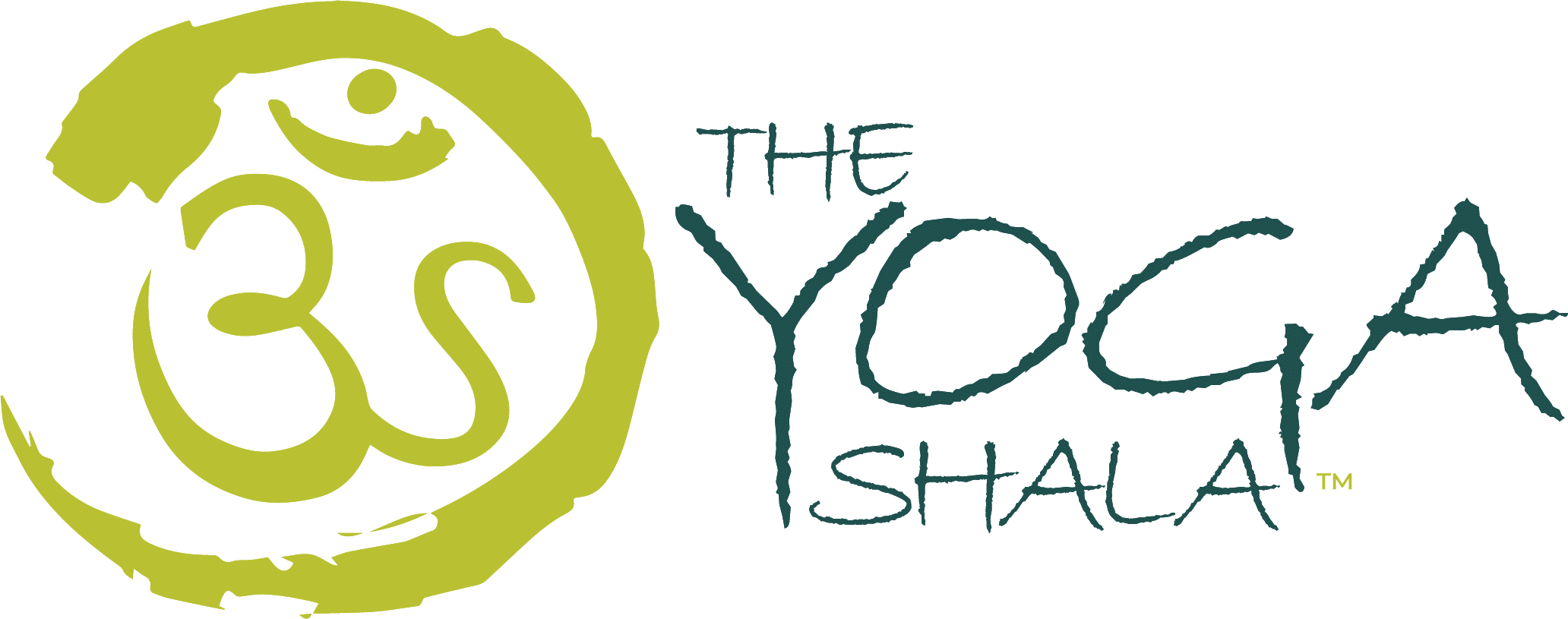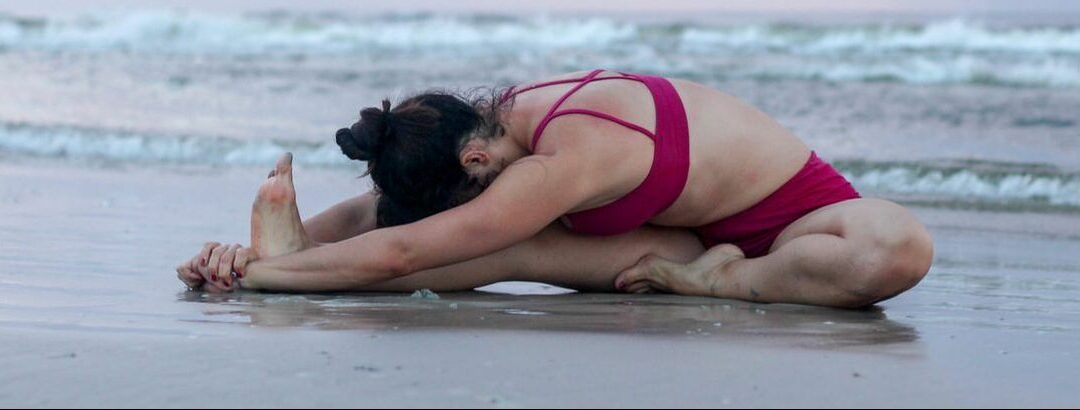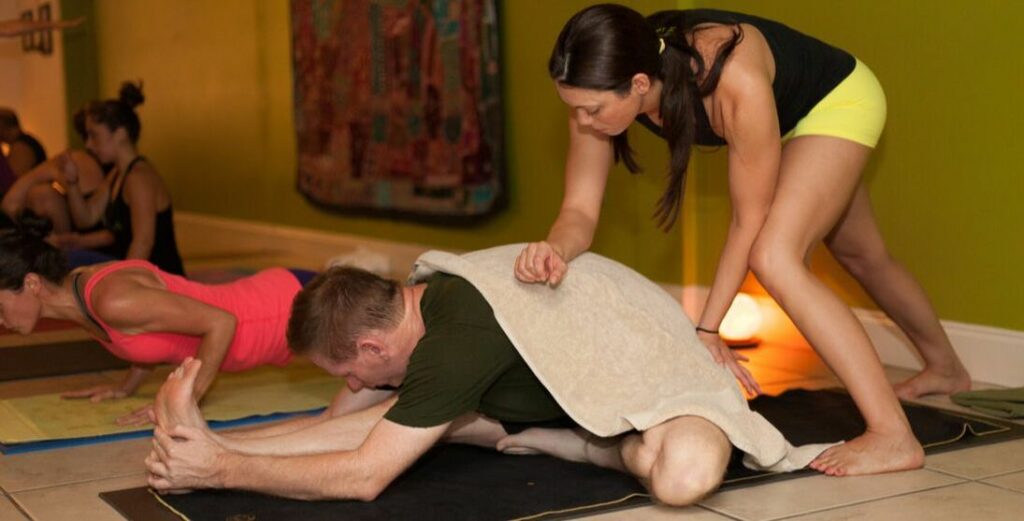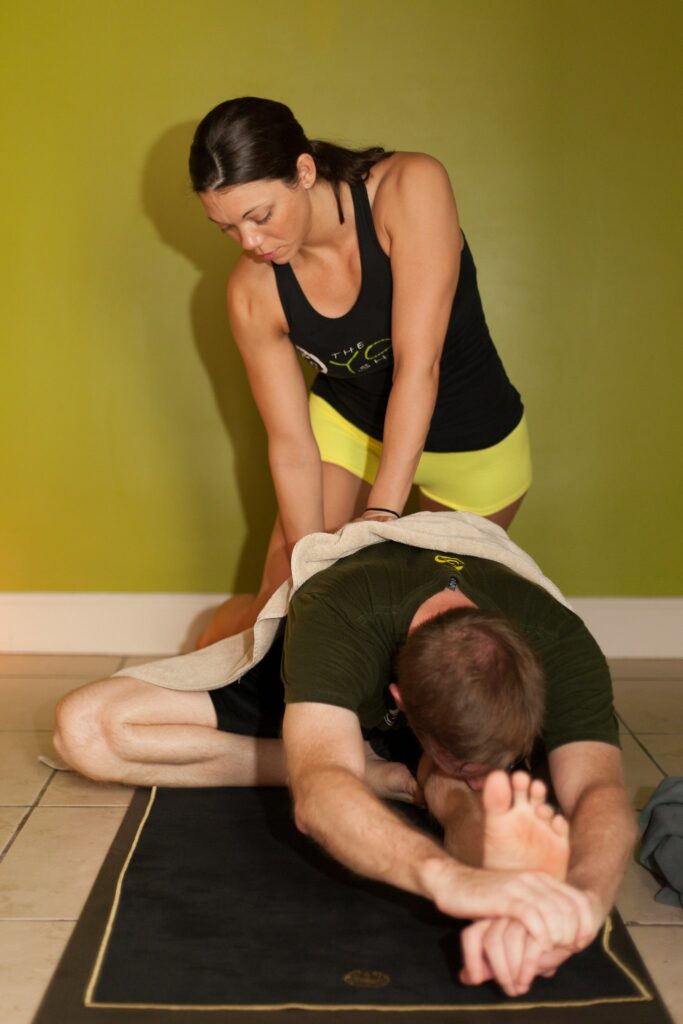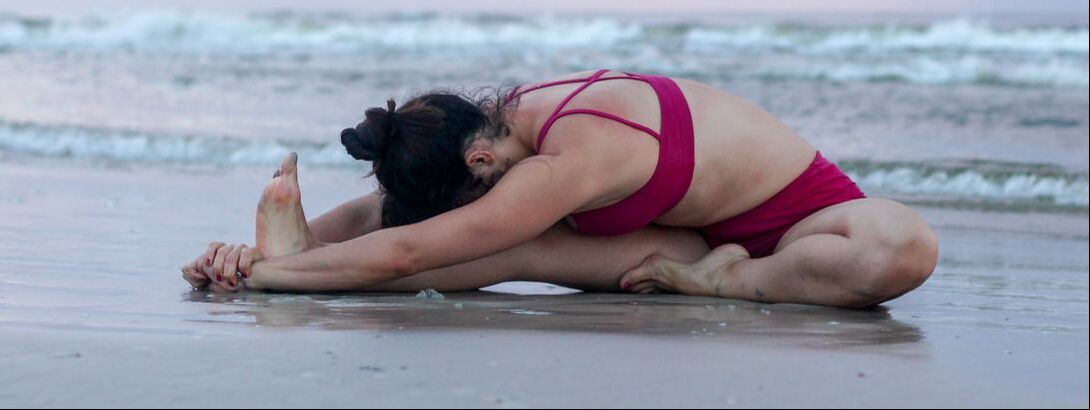Ashtanga Yoga is a dynamic and traditional form of yoga that involves a specific sequence of poses designed to align the body, calm the mind, and strengthen the spirit. Janu Sirsasana A, also known as Head-to-Knee Pose A, is one of the asanas (poses) from the Ashtanga Yoga Primary Series.
This is the eleventh pose of the Ashtanga Yoga Primary series, and the sixth seated posture in that series. Janu Sirsasana A offers numerous benefits, including stretching the hamstrings, improving flexibility, and promoting a sense of introspection. In this comprehensive guide, we’ll walk you through the steps to achieve Janu Sirsasana A effectively.
I’ve also written a blog post exploring Janu Sirsasana B and C from the Primary Series. Click here to access Janu Sirsasana B post, and here to access Janu Sirsasana C.
Benefits of Janu Sirsasana A
Before diving into the practice itself, let’s explore some of the benefits that Janu Sirsasana A has to offer:
Hamstring Stretch:
This pose deeply stretches the hamstrings, helping to improve flexibility and release tension in the back of the legs.
Side body Stretch:
When practiced with bent leg at 90 degree angle, this is a delightful stretch for the side of your body. Consistently practicing this posture will lengthen the latissimus dorsi and serratus anterior, the rotator cuffs, and hips.
Spinal Flexibility:
Janu Sirsasana A encourages the spine to flex forward, promoting suppleness in the back muscles and maintaining a healthy spine.
Digestive Stimulation:
The pose massages the abdominal organs, aiding digestion and promoting overall digestive health.
Calming Effect:
Janu Sirsasana A is a forward-bending pose, which has a soothing and calming effect on the nervous system, reducing stress and anxiety.
Blood Circulation:
Janu Sirsasana A can improve blood circulation to the pelvic region and lower abdomen, which can have positive effects on reproductive health.
Introspection:
The pose invites a sense of turning inward and introspection, allowing for self-reflection and mindful awareness.
Click here to watch the YouTube tutorial for Janu Sirsasana A
Contraindications and Precautions
While Janu Sirsasana A offers numerous benefits, there are certain conditions and situations in which it might not be suitable or require modifications:
Hamstring or Back Injuries:
Individuals with acute hamstring injuries or lower back issues should approach this pose cautiously. Consult a healthcare professional or a qualified yoga instructor advice before taking this posture. And be sure that when you start this posture, you begin with a modification to safely allow the body to open over time.
Knee Injuries:
If you have knee injuries, be careful when bending the knee of the extended leg. Consider taking one of the modifications offered below or avoid this pose altogether if it causes discomfort.
Pregnancy:
Pregnant women should modify this pose by keeping the knees slightly bent and avoiding deep forward bends that could strain the abdominal muscles.
High Blood Pressure:
If you have high blood pressure, approach this pose with caution. Avoid excessive forward folding and keep your head elevated to prevent a sudden drop in blood pressure.
Diarrhea or Menstruation:
During periods of diarrhea or menstruation, it’s advisable to skip or modify this pose, as the forward fold can create discomfort.
Recent Abdominal Surgery:
If you’ve had recent abdominal surgery, consult your healthcare provider before attempting this pose, as it involves pressure on the abdomen.
The Angles of the Janu Sirsasana Postures
Angles for your foot position will make even more sense once we explore Janu Sirsasana B and C in posts. In Janu Sirsasana A, we seek a 90 degree angle from your knee. Consequently, we are to bring our toes to touch our opposite inner thigh. This ensure we don’t press the entire foot into the opposite thigh. By using this angle, you are taking the posture correctly. In turn this gives you a delicious and safe stretch of your entire side body and Latissimus Dorsi. In Janu Sirsasana B, we will take a slightly smaller angle, around 60 degrees. Comparatively, in Janu Sirsasna C we aspire to create a 45 degree angle.
Now, let’s delve into the step-by-step instructions for practicing Janu Sirsasana A:
Step-by-Step Guide to Janu Sirsasana A (Sanskrit Vinyasa Count)
We will be entering this posture from downward facing dog, having just taken a vinyasa after Trianga Mukhaikapada Paschimottanasana to seated position.
Sapta (Vinyasa #7): From Adho Mukha Svanasana (down dog), look forward and walk or jump your feet through and have a seat on the floor with your legs extended in front of you. Inhale, bend your right knee and drop your right knee down and out to the right.
Take your knee out to 90 degree angle from your hip and draw the toes of your right foot in to touch your inner left thigh. Lengthen your spine and stretch both arms forward and grab your left foot with both hands. Left foot is flexed. Head up.
Asthau (Vinyasa #8) Exhale and fold forward out over your straight left leg. Be sure you maintain flexion in your left foot, engage the left quadricep and press your heel forward as you press your tailbone backward. Bring your chin to your chin if you can. Look towards your toes (Padhayoragrai drishti). Breathe here for five deep breaths. With each inhale, elongate your spine, lifting your chest slightly.
Adjustments and Alignment Tips:
-
- Keep both sitting bones grounded to maintain balance.
- Flex your left foot actively to engage the muscles and protect the knee.
- Lengthen your spine on each inhale and deepen the stretch on each exhale.
Breathing:
-
- The vinyasa count guides your breath. Inhale during the lengthening phases and exhale during the folding phases.
- Maintain deep breathing with sound —a deep, audible breath—throughout the pose to help you stay focused and relaxed.
Nava (Vinyasa #9) Inhale, lift your head and lengthen your spine. Keep your hands bound around your feet. Exhale there.
Dasa (Vinyasa #10) Inhale, bring your hands to the floor, cross your legs and lift your body up off the ground.
Ekadasa (Vinyasa #11) Exhale and jump back into Chaturanga Dandasana.
Dvadasa (Vinyasa #12) Inhale into Urdhva Mukha Svanasana(Upward facing dog)
Trayodasa (Vinyasa #13) Exhale into Adho Mukha Svanasana (Downward facing dog)
Caturdasa (Vinyasa #14) From Adho Mukha Svanasana (down dog), look forward and walk or jump your feet through and have a seat on the floor with your legs extended in front of you. Inhale, bend your left knee and drop your left knee down and out to the left.
Take your knee out to 90 degree angle from your hip and draw the toes of your left foot in to touch your inner right thigh. Lengthen your spine and stretch both arms forward and grab your left foot with both hands. Right foot is flexed. Head up.
Pancadasa (Vinyasa #15) Exhale and fold forward out over your straight right leg. Be sure you maintain flexion in your right foot, engage the right quadricep and press your heel forward as you press your tailbone backward. Bring your chin to your chin if you can. Look towards your toes (Padhayoragrai drishti). Breathe here for five deep breaths. With each inhale, elongate your spine, lifting your chest slightly.
Sodasa (Vinyasa #16) Inhale, lift your head and lengthen your spine. Keep your hands bound around your feet. Exhale there.
Saptadasa (Vinyasa #17) Inhale, bring your hands to the floor, cross your legs and lift your body up off the ground.
Ashtadasa (Vinyasa #18) Exhale and jump back into Chaturanga Dandasana.
Ekoonavimsatih (Vinyasa #19) Inhale into Urdhva Mukha Svanasana(Upward facing dog)
Vimsatih (Vinyasa #20) Exhale into Adho Mukha Svanasana (Downward facing dog)
Tips and Modifications
Modifications are essential in yoga to make poses accessible to a wider range of practitioners and to accommodate individual needs and limitations. Here are some modifications for Janu Sirsasana A:
Focus on the Upper Body:
If hamstring flexibility is a challenge, focus on elongating your spine and reaching your chest forward, rather than aiming to touch your foot. This modification can still provide a good stretch without overexerting your hamstrings.
Bent Knee Variation:
If you have tight hamstrings or discomfort in the knee of the extended leg, you can choose to keep the knee slightly bent. This modification can reduce strain on the hamstring and make the pose more accessible.
Wall Support:
Practicing Janu Sirsasana A with your back against a wall can help you maintain proper alignment. The wall can serve as a support, allowing you to focus on the forward fold without worrying about balance.
Precautions:
- Avoid rounding your back excessively. Focus on the forward fold coming from the hips rather than the spine.
- If you have any knee, hip, or lower back injuries, consult a yoga instructor or healthcare professional before attempting this pose.
Janu Sirsasana A offers a range of physical, mental, and emotional benefits. As you practice this pose regularly, you’ll likely notice improvements in your flexibility, concentration, and overall well-being. Remember that yoga is a journey, and each practice is an opportunity to deepen your connection with your body and mind. Enjoy the process, and allow Janu Sirsasana A to be a gateway to greater self-awareness and tranquility.
Practice with The Yoga Shala
If you want to join us for LIVE classes, The Yoga Shala offers virtual and in person classes every weekday morning. We are located at 140 Circle Drive, #4, Maitland, Florida. Owner, Krista Shirley, also offers virtual or in person private sessions (Yoga, Meditation, Breath-work, Nutrition, Life Coaching and Mentorship). Visit theyogashala.com for details.
Be sure to signup for our newsletter to stay on top of local events and classes, Nysa products sales, new offerings, new products and more!
We hope you find this video series helpful to you in creating or maintaining your yoga practice!
About Krista
Krista Shirley is a level II authorized Ashtanga Yoga teacher. She is deeply passionate about sharing these teachings with all who wish to learn.
If you want to join Krista in person she teaches daily classes at The Yoga Shala in Maitland, Florida. She also offers virtual sessions in Yoga, Meditation, Breath-work, Nutrition, Life Coaching and Mentorship. Check out www.theyogashala.com for more details.
If you do not live in Central Florida and want to find an authorized teacher in your area, check out our teacher, Sharath Jois’ website, for a list of all teachers authorized and certified by his yoga centre in India.
|
|
|
|
|
|
|
|
|
|
|
|
❤️SHOP MERCHANDISE: Nysa Products
❤️LET’S BE SOCIAL:
Instagram: Krista Shirley Yoga
Instagram: The Yoga Shala
Facebook: The Yoga Shala
Facebook: KristaShirleyYoga
For other inquires please contact: [email protected]
